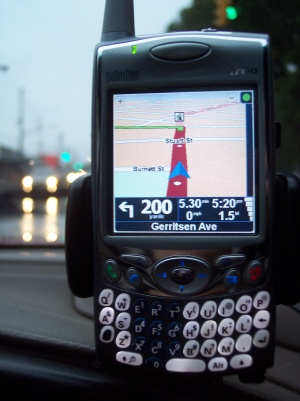If you wish to contribute or participate in the discussions about articles you are invited to contact the Editor
Road Navigation
| Applications | |
|---|---|
| Title | Road Navigation |
| Author(s) | Rui Barradas Pereira, GMV |
| Level | Basic |
| Year of Publication | 2011 |
Car navigation is still one of the main applications of GNSS, as reported in the GNSS Market Report, Issue 3. GNSS data combined with electronic maps allow positioning and guidance of the road user.
Route guidance using satellite navigation is already a well-established product offered both by car manufacturers and standalone navigation devices. The majority of these systems are based on satellite navigation systems that can be integrated with onboard sensors (odometer and gyros) to compute optimal routes in real-time[1].
Application Architecture
Road Navigation applications are implemented using an in-vehicle navigation device, a standalone Personal Navigation Device or a standalone application running on a GNSS-enabled mobile device.
Normally the map and database of these applications are local, although in some case the local application is supported by online services that provide database updates, additional dynamic data (such as traffic information) or even parts of the navigation functionality. Although these road navigation devices do not require internet access, they can benefit from internet access to have real-time traffic information that can be used by the routing algorithms. The internet access can be done directly by the device (specially in the case of applications running in mobile phones) or through the driver's phone using Bluetooth.
The process normally followed by these applications is[2]:
- The user configures the application by defining a destination. Restrictions may be applied on how to get to the destination (e.g. use of tolled road).
- The application uses street and road maps (vectorial maps) to calculate the best route according with the user configuration and restrictions.
- The application will guide the driver turn by turn using visual and audio information.
- If the user diverts from the suggested route the application will recalculate the route.
- These applications normally include a point-of-interest (POI) database including hotel, restaurant, gas station and other landmark information.
- Usually these applications provide pedestrian navigation, normally restricted to street and road sidewalk navigation (normally doesn't include public transportation, pedestrian pathways or indoor navigation).
More advanced functionality that might not be present in all devices can be:
- Lane Indication: Indication of the lane to take in intersection sometimes including the display of the road signs to follow.
- Speed Warning: Alarms are provided to the driver when the speed limits are violated sometimes with the indication of the location of speed cameras.
These applications are considered non-critical applications.
The accuracy required by these applications is low. The current accuracy provided by civilian GPS is enough in most situations.
Application Characterization
Routing
These applications typically offer 2 routing algorithms:
- Fastest Route: Calculates the fastest route based on the speed classification of the streets and roads.
- Shortest Route: Calculates the shortest route
Some manufacturers offer additional routing modes that take into consideration traffic conditions to choose the fastest route. These routing modes either use online servers that provide the current road conditions and incorporate this information in the routing algorithm or can use learning algorithms to learn traffic flow trends depending on the time of day and day of week. These learning algorithms can either use only local data from the driver or data collected from other users.
Another routing algorithm that is being offered by some manufacturers is the Ecological Route that calculates the route that will cause lesser impact in environment and lowest fuel consumption. Some devices can even connect with the vehicle on-board diagnostics (OBD) to collect the actual vehicle consumption and incorporate the vehicle's and driver's fuel consumption profile on the routing algorithms.
Road View
These applications usually provide 2 road views modes:
- 2D Map View: The map is viewed in 2D from above. The map is rotated depending on the direction of the movement (up corresponds to forward).
- 3D Bird's Eye: The map is viewed from a simulated 3D view from above the road oriented towards the direction of the movement.
Some manufacturers include the possibility of using satellite images for the road views and even 3D building data and elevation data. These devices provide a richer interface making it easier for the driver to identify the landmarks and the intersections to take.
The road view can be complemented by visual indication of speed, estimated time of arrival or time left, distance left, lane to take, speed limit and/or road signs to follow.
Turn-by-turn audio indications will complement the visual information provided on the screen
Application Examples
The main road navigation application providers are[3]:
- Garmin: Provides consumer GNSS devices for outdoor, road, maritime and aviation
- TomTom: Sells road navigation consumer devices. Owner of road map provider Tele Atlas.
- MiTAC: Manufactures IT products for several market including the navigation area. Their products are sold under the brands Mio, Navman and Magellan.
The main street and road map providers are[3]:
- Navteq: Leader in digital map provision. Is owned by Nokia although it continues to provide mapping to external customers.
- Tele Atlas: Netherlands-based company currently owned by TomTom.
Notes
References
- ^ Galileo Application Sheet - Road Applications, ESA and European Commission, October 2002
- ^ Automotive navigation system in Wikipedia
- ^ a b GSA GNSS Market Report – Issue 1, October 2010.

